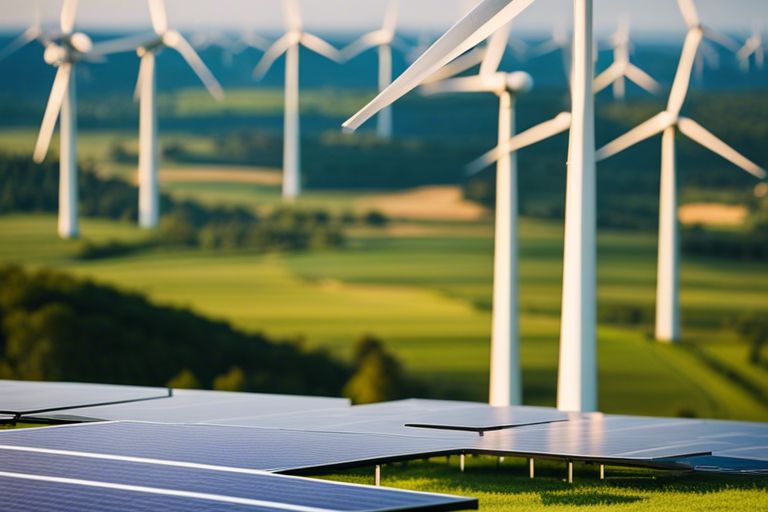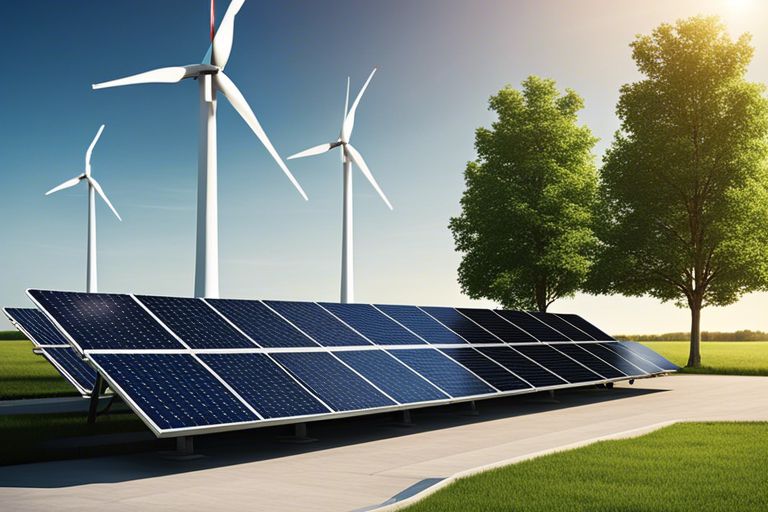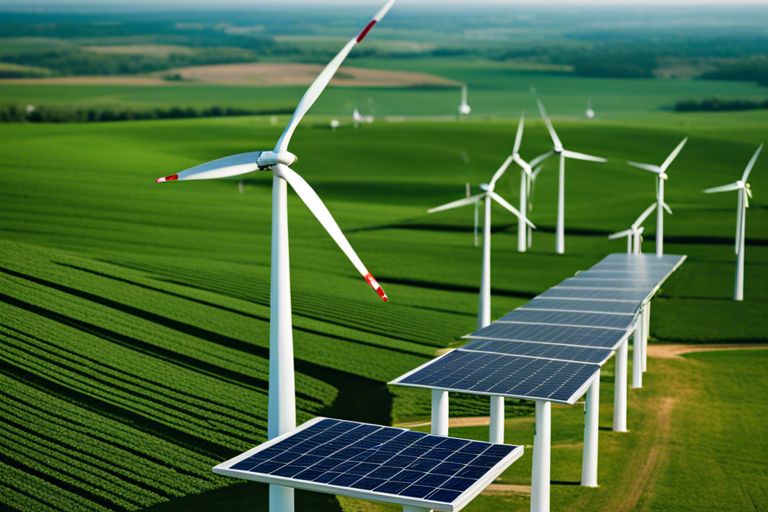You have likely heard about the increasing demand for sustainable and clean energy solutions in today’s world. As the global focus on environmental conservation and reducing carbon emissions grows stronger, renewable energy sources have emerged as a key player in meeting these goals. Investing in renewable energy has become more than just a trend; it is a strategic decision that aligns with the shifting landscape towards sustainable practices.
Renewable energy technologies, such as solar, wind, hydro, and geothermal power, offer a promising avenue for investors looking to capitalize on the transition to cleaner energy sources. By understanding the potential of renewable energy investments and staying informed about industry developments, individuals and businesses can position themselves to benefit from the opportunities presented by the growing demand for sustainable energy solutions. This blog post aims to explore the potential benefits and considerations of investing in renewable energy, highlighting the significant role it plays in shaping the future of energy production and consumption.

The Fundamentals of Renewable Energy Investment
Before plunging into renewable energy investment, it is crucial to understand the basics of this rapidly growing sector. Renewable energy sources are derived from natural processes that are constantly replenished, such as sunlight, wind, and water. Investing in renewable energy involves capitalizing on the sustainable trends that are driving the transition towards cleaner and more environmentally friendly energy solutions.
Types of Renewable Energy
One of the key aspects to consider when investing in renewable energy is the various types of sources available. These include solar, wind, hydroelectric, geothermal, and biomass energy. Each type offers unique opportunities for investment, with different levels of maturity and potential for growth. For instance, solar energy has seen significant advancements in technology and cost reductions, making it a lucrative option for investors looking to capitalize on the increasing demand for clean energy solutions.
| Solar Energy | Utilizes sunlight to generate electricity through photovoltaic cells or concentrated solar power systems. |
| Wind Energy | Harnesses the power of wind to generate electricity through wind turbines. |
| Hydroelectric Energy | Generates electricity from flowing water through dams and turbines. |
| Geothermal Energy | Utilizes heat from beneath the Earth’s surface to generate electricity or heat buildings. |
| Biomass Energy | Uses organic materials such as wood, crop residues, and waste to produce energy through combustion or biochemical processes. |
Understanding the Market Drivers for Renewable Energy
Renewable energy investment is driven by a combination of environmental concerns, government policies, technological advancements, and market forces. As the demand for sustainable and clean energy solutions continues to grow, investors are increasingly looking towards renewable energy as a profitable and socially responsible investment opportunity. It is important to understand the key market drivers that are shaping the renewable energy sector and influencing investment decisions.
Assume that government incentives, such as tax credits and subsidies, play a crucial role in promoting the development and adoption of renewable energy technologies. Understanding the various market drivers can help investors make informed decisions and capitalize on the opportunities presented by the shift towards a more sustainable energy future.

Evaluating Investment Opportunities
All investors looking to capitalize on the growing demand for sustainable and clean energy solutions should consider the insights provided in the Venture Capital Trends 2024: Clean Energy and Sustainability article. This resource offers valuable information on emerging trends and investment opportunities in the renewable energy sector, guiding investors towards lucrative prospects.
Direct vs. Indirect Investment Strategies
To maximize returns in renewable energy investing, it is imperative to carefully consider the choice between direct and indirect investment strategies. Direct investments, such as acquiring ownership in renewable energy projects or companies, offer a higher level of control and potential returns. On the other hand, indirect investments through funds or exchange-traded products provide diversification and professional management, mitigating individual project risks.
Risk Assessment and Management in Renewable Energy Investments
An integral aspect of evaluating renewable energy investment opportunities is conducting a thorough risk assessment and implementing effective risk management strategies. Understanding the inherent risks in renewable energy projects, such as technology, regulatory, and market risks, is crucial for making informed investment decisions. By diversifying portfolios across different technologies and geographic locations, investors can minimize risk exposure and enhance long-term sustainability in their investments.
Another key factor in risk management for renewable energy investments is staying informed about industry developments and policy changes. With the renewable energy sector evolving rapidly, ongoing monitoring and adaptation to changing market conditions are imperative for optimizing investment performance and ensuring long-term success.

Financing Renewable Energy Projects
Public Financing Options
Projects in the renewable energy sector often require substantial upfront capital investment, and public financing options can be a critical source of funds for such projects. Governments at various levels offer incentives such as grants, tax credits, and subsidies to support the development of renewable energy projects. These financial incentives aim to stimulate investment in clean energy and accelerate the transition towards sustainable energy solutions. For example, according to data, the global investment in renewable energy reached $332.1 billion in 2018, reflecting the growing interest and support for renewable energy projects.
Private Financing and Venture Capital
Private financing and venture capital play a significant role in funding renewable energy projects, especially for startups and innovative technologies in the sector. Investors seek opportunities to capitalize on the growing demand for clean energy solutions and sustainable investments. Beyond traditional financing methods, venture capital firms and private equity investors are increasingly allocating funds towards renewable energy projects. These investments not only drive innovation in the sector but also contribute to the overall growth and expansion of renewable energy markets.
Private financing and venture capital investments in renewable energy projects are expected to continue to rise as the demand for sustainable alternatives to fossil fuels grows. According to industry reports, venture capital investments in renewable energy companies reached $9.2 billion in 2020, underscoring the strong interest and potential returns in this sector.
The Role of Technological Innovation in Renewable Energy Investment
Not only do technological advances play a crucial role in driving the evolution of the renewable energy sector, but they also present significant opportunities for investors looking to capitalize on sustainable trends. As outlined in The Biggest Funding Surges in Renewable Energy and Sustainability Tech, the current landscape showcases a surge in funding for innovative solutions that are reshaping the renewable energy industry.
Advancements in Energy Storage and Battery Technology
Technology continues to revolutionize the renewable energy market, with a particular focus on energy storage and battery technology. The ability to store excess renewable energy generated from sources like wind and solar power is critical for ensuring a reliable and consistent energy supply. This has triggered significant investments in developing advanced energy storage solutions that can balance supply and demand more efficiently, contributing to the transition towards a cleaner and more sustainable energy system.
Cutting-edge Developments in Renewable Energy Generation
Energy innovation plays a key role in shaping the future of renewable energy generation. As demand for sustainable and clean energy solutions grows, the sector is witnessing cutting-edge developments in technologies such as wind turbines, solar panels, and hydropower systems. These advancements not only enhance the efficiency and reliability of renewable energy sources but also drive down costs, making them more competitive with traditional fossil fuel-based energy generation methods. Renewable energy continues to be a focus for investors seeking to align their portfolios with environmentally conscious and financially lucrative opportunities.
The Economic Impact of Investing in Renewable Energy
Job Creation and Economic Development
Impact: For countries and regions looking to stimulate economic growth and create jobs, investing in renewable energy can be a game-changer. The renewable energy sector has already proven to be a significant source of employment opportunities, with the International Renewable Energy Agency estimating that the sector employed nearly 12 million people globally in 2019. By further investing in renewable energy technologies, countries can generate even more jobs across the entire value chain, from manufacturing and installation to maintenance and research and development.
Cost Competitiveness with Fossil Fuels
Economic Impact: Renewable energy sources like wind and solar power have become increasingly cost competitive with fossil fuels in recent years. The levelized cost of electricity (LCOE) from solar photovoltaics has dropped by 89% since 2010, making it one of the most affordable sources of electricity in many parts of the world. This cost competitiveness not only makes renewable energy investments financially attractive but also helps reduce the overall cost of electricity for consumers, leading to economic savings in the long run.
Fuels: The declining costs of renewable energy technologies, coupled with their environmental benefits, have led to an increasing number of countries and companies shifting away from fossil fuels and towards cleaner energy sources. This transition is not only beneficial for the environment but also offers economic opportunities for investors looking to capitalize on the growing demand for sustainable energy solutions.
Global Perspectives on Renewable Energy Investment
Leading Countries in Renewable Energy Investment
Now, as the global demand for sustainable and clean energy solutions continues to rise, several countries have positioned themselves as leaders in renewable energy investment. According to data from the International Energy Agency, countries such as China, the United States, and Germany have consistently been at the forefront of renewable energy investment, with significant contributions to the growth of the industry.
Emerging Markets and International Growth Opportunities
Countries across the globe are recognizing the potential of investing in renewable energy to meet their energy needs and address environmental concerns. Renewable energy technologies offer a way to diversify energy sources and reduce carbon emissions. In emerging markets, such as India and Brazil, there is a growing momentum towards renewable energy investments, presenting international growth opportunities for investors.
With the global shift towards sustainability, emerging markets are becoming increasingly attractive for renewable energy investments. These countries offer a vast potential for growth in renewable energy infrastructure, with supportive policies and a growing demand for clean energy solutions driving investment opportunities. For investors looking to capitalize on the sustainable trends in the energy sector, exploring emerging markets could prove to be a strategic move.
Portfolio Diversification with Renewable Energy
Balancing Renewable Energy in an Investment Portfolio
Despite the inherent risks associated with any investment, diversification is a key strategy to mitigate potential losses. Incorporating renewable energy assets into your investment portfolio can provide a hedge against volatility in traditional energy markets. By allocating a portion of your funds to renewable energy projects, you not only contribute to a sustainable future but also benefit from the growing demand for clean energy solutions.
Investment in renewable energy can also provide stability to your portfolio by offering long-term, predictable returns. With the increasing global focus on reducing carbon emissions and transitioning to a low-carbon economy, renewable energy assets are poised for significant growth potential in the coming years.
Renewable Energy’s Role in ESG (Environmental, Social, Governance) Investing
With the rise of ESG (Environmental, Social, Governance) investing, renewable energy has become a focal point for investors looking to align their financial goals with sustainability principles. Investing in renewable energy projects not only generates attractive financial returns but also contributes to positive environmental and social impacts.
This is further supported by the fact that renewable energy investments have shown strong performance in recent years. According to data from the context, the growing demand for sustainable and clean energy solutions underscores the potential for substantial returns in the renewable energy sector, making it an attractive option for ESG-conscious investors.
Navigating Challenges and Mitigating Risk
The Intermittency of Renewable Energy Sources
After recognizing the potential for investing in renewable energy, it is crucial to understand and address the challenges that come with harnessing energy from sources such as solar and wind. One significant obstacle is the intermittency of these renewable sources, as their availability varies based on weather conditions and time of day.
On the positive side, advancements in energy storage technologies are helping to mitigate this issue. Batteries and other storage solutions are becoming increasingly efficient and affordable, allowing excess energy generated during peak times to be stored for use when production is lower, ensuring a more consistent supply of clean energy.
Overcoming Infrastructural and Regulatory Hurdles
Intermittency is not the only obstacle to investing in renewable energy. Infrastructure limitations and complex regulatory frameworks can also pose challenges for initiatives in this sector. Developing and implementing the necessary infrastructure for renewable energy projects, such as transmission lines and grid integration, requires significant investment and coordination across various stakeholders.
With the growing demand for sustainable energy solutions, governments worldwide are increasingly adopting supportive policies and regulations to incentivize investments in renewable energy. Understanding and complying with these regulations is necessary for mitigating risk and ensuring the success of renewable energy projects.
The Future of Renewable Energy Investment
Once again, the potential of investing in renewable energy is becoming increasingly promising as the world shifts towards sustainable and clean energy solutions. With the growing demand for renewable energy sources, investors have a unique opportunity to capitalize on this trend while contributing to a more sustainable future.
Trends to Watch in the Renewable Energy Space
An important trend to watch in the renewable energy space is the increasing adoption of solar and wind power technologies. According to a report by the International Energy Agency, renewable energy capacity is set to expand by 50% over the next five years, with solar and wind leading the way in terms of growth.
Long-Term Projections and Market Potential
Energy experts predict that renewable energy sources will account for a significant portion of the global energy mix in the coming years, with estimates suggesting that renewable energy could make up 30% of global electricity generation by 2030. This presents a massive market potential for investors looking to capitalize on the renewable energy sector.
Watch this space closely as advancements in technology and favorable government policies continue to drive the growth of renewable energy investments around the world.

Conclusion
Now is the perfect time to capitalize on the growing demand for sustainable and clean energy solutions by investing in renewable energy. As the world continues to shift towards a more environmentally conscious mindset, renewable energy sources are becoming increasingly vital in the fight against climate change. With advancements in technology and government incentives driving the renewable energy market forward, there is tremendous potential for investors to reap significant returns while also contributing to a more sustainable future.
Thus, investing in renewable energy not only offers lucrative financial rewards but also aligns with the global movement towards a more sustainable future. By taking advantage of this growing trend and committing to renewable energy investments, investors have the opportunity to make a positive impact on the environment while also securing their financial future in a rapidly evolving energy landscape. The time to act is now – seize the opportunity and invest in a cleaner, greener future.
FAQ
Q: Why should I consider investing in renewable energy?
A: Investing in renewable energy offers long-term sustainability and growth potential as the world shifts towards cleaner and more environmentally friendly energy sources.
Q: What are some examples of renewable energy sources?
A: Renewable energy sources include solar, wind, hydroelectric, geothermal, and biomass energy, which are abundant and eco-friendly alternatives to traditional fossil fuels.
Q: How can investing in renewable energy contribute to a more sustainable future?
A: By investing in renewable energy, you are supporting the reduction of greenhouse gas emissions, promoting energy independence, and helping combat climate change for a more sustainable future.
Q: Are there any financial incentives for investing in renewable energy?
A: Many governments offer subsidies, tax credits, and other financial incentives to encourage investments in renewable energy projects, making it an attractive option for investors.
Q: What are some risks associated with investing in renewable energy?
A: While renewable energy investments offer great potential, risks may include regulatory changes, technological advancements, and market fluctuations that could impact returns on investment.




